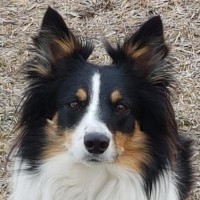Appearance of the Border Sheepdog
|
| The Border Sheepdog's appearance can be difficult to determine, depending on the number of different varieties its parent breeds can enter. The typical Border Sheepdog can have large ears fringed in hair, a long, soft coat that can come in a variety of different colors, and can vary in size from very small to medium. Their eyes are light or dark brown and full of life and intelligence. Border Collies are known for their intimidating stare that makes herds move, so be aware that your Border Sheepdog may also look at you or look down to force his will on them. There's also the rare possibility of blue eyes occurring in the Border Sheepdog, but if this happens, one or both ears may be deaf. The Border Sheepdog does best in mild climates due to its double coat and tends to shed often. |
Temperament of the Border Sheepdog
|
| Combine the personalities of the Border Collie and the Shetland Sheepdog and you have perhaps the most dynamic combination in history. Indeed, both breeds are extremely intelligent, highly athletic and not at all designed for lounging around the house. Although extremely easy to train with patience, it is of the utmost importance that a Border Sheepdog owner knows what he's getting into and is determined enough to face it. This dog can't be left alone outside, and certainly can't stand being trapped inside the house all day. To train this hybrid dog properly and keep him happy and content, you'll need to spend a lot of time training and spending quality time with him. Border Collies and Shetland Sheepdogs are very attached to their owners and eager to please. They do well with older children and animals, however, be prepared to feel breeding instincts directed towards others if your Border Sheepdog is not properly trained. This is a natural instinct that will have to be mastered. Because both parent breeds are also meant to be guard dogs, suspicion of strangers may occur initially, then recede once the dog is more at ease. Finally, the Shetland Sheepdog is known to bark often, so more suburban areas are better for your Border Sheepdog if it takes on this specific side of the gene pool. Although the Border Sheepdog is a handful, if proper training and socialization take place young, you'll have an incredible herding dog, show dog or companion that's perfect for the athletic individual. |
Needs and activities of the Border Sheepdog
|
| Because the Border Sheepdog has extremely active and intelligent parent breeds, it's going to need plenty of physical and mental stimulation throughout the day. This includes activities such as intense training, jogging, biking, hiking, long walks and playing lots of fetch in the yard. Fortunately, because this breed has a double-layered coat, he'll do just fine exercising outdoors during the winter months. Be sure to give your Border Sheepdog plenty of exercise so he doesn't become destructive. High-energy dogs who don't have a way of releasing their energy productively tend to destroy the things you enjoy. However, if you can spend 1-2 hours a day giving your Border Sheepdog good mental and physical stimulation, he'll be perfectly content and happy. On top of that, because of the Border Collie's breeding instinct, without proper training your Border Sheepdog may end up guarding young children, other animals or adults who have no authority over him. Be sure to train for a significant amount of time each day to properly limit these behaviors. |
Maintenance of the Border Sheepdog
|
| The Border Sheepdog is a relatively low-maintenance breed. Because of its undercoat, it tends to shed moderately throughout the year, with rather greater shedding twice a year. The best way to keep his long, soft coat in perfect condition is to brush it thoroughly at least twice a week with an undercoat rake, a smooth brush and a pin brush. Bathing should only be done occasionally, or when your dog is particularly dirty. In addition to brushing and bathing, be sure to trim your Border Sheepdog's nails every few weeks or when you can hear them clicking against the floor. |









 English (United Kingdom)
English (United Kingdom)